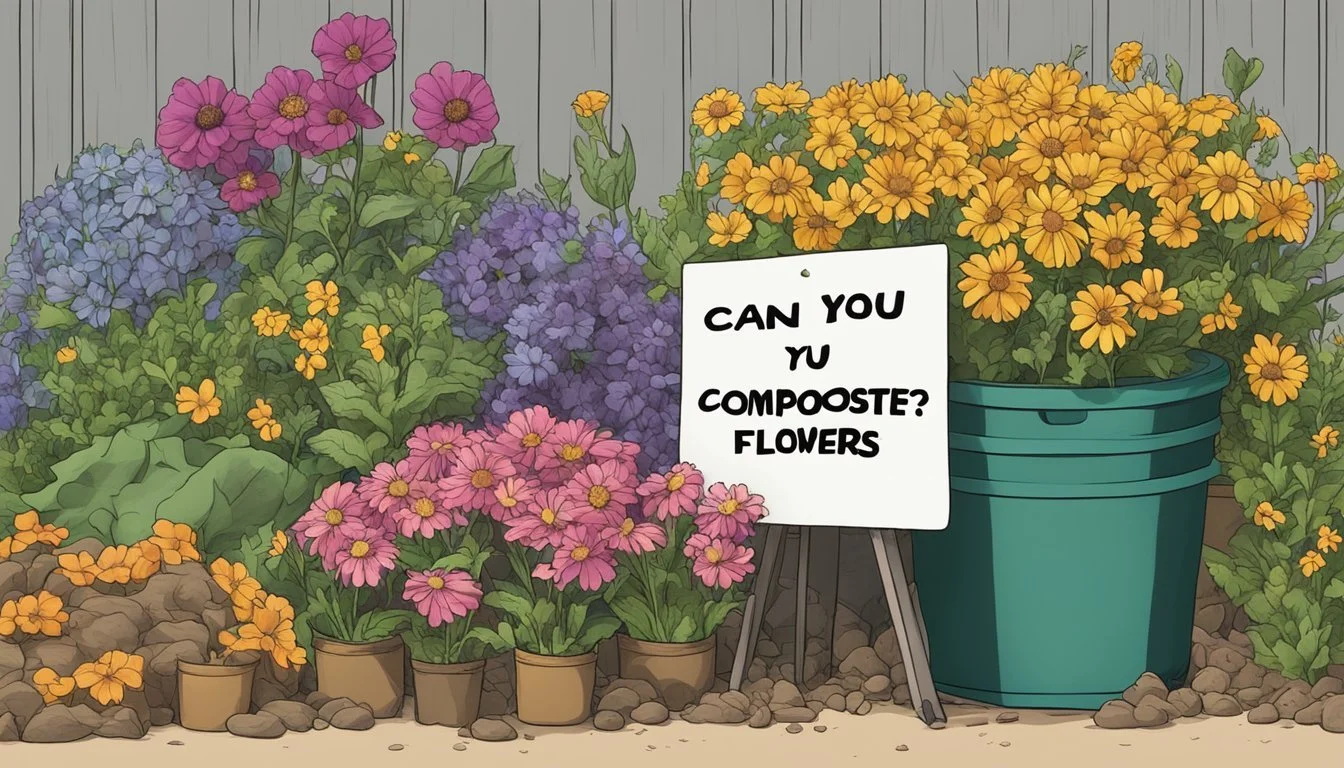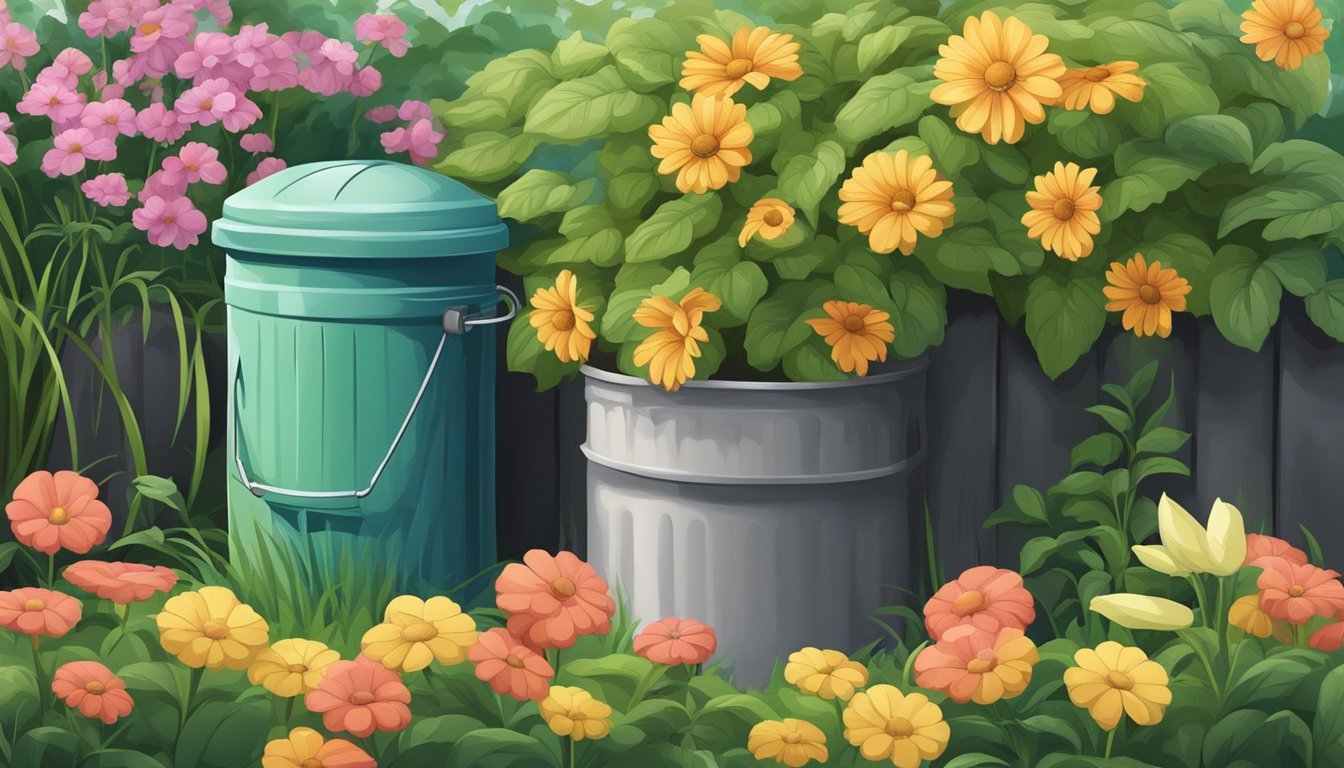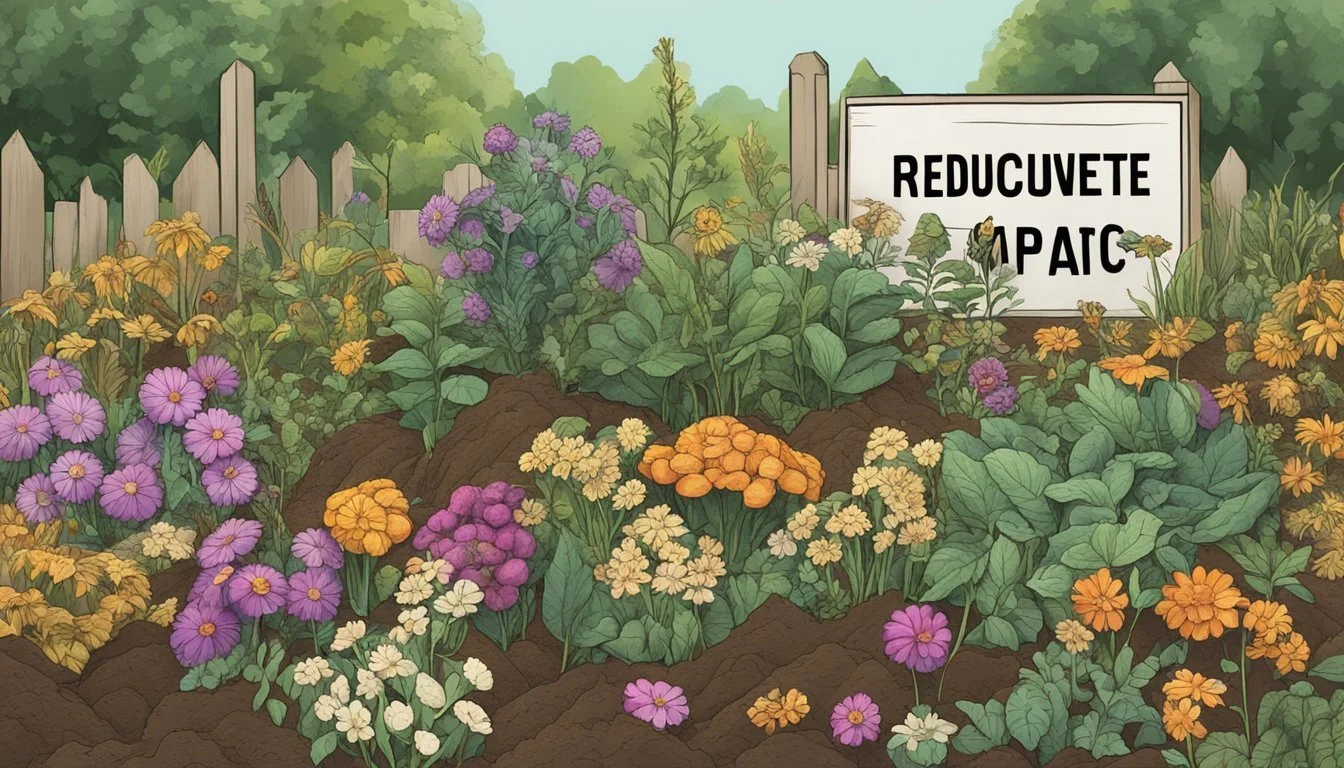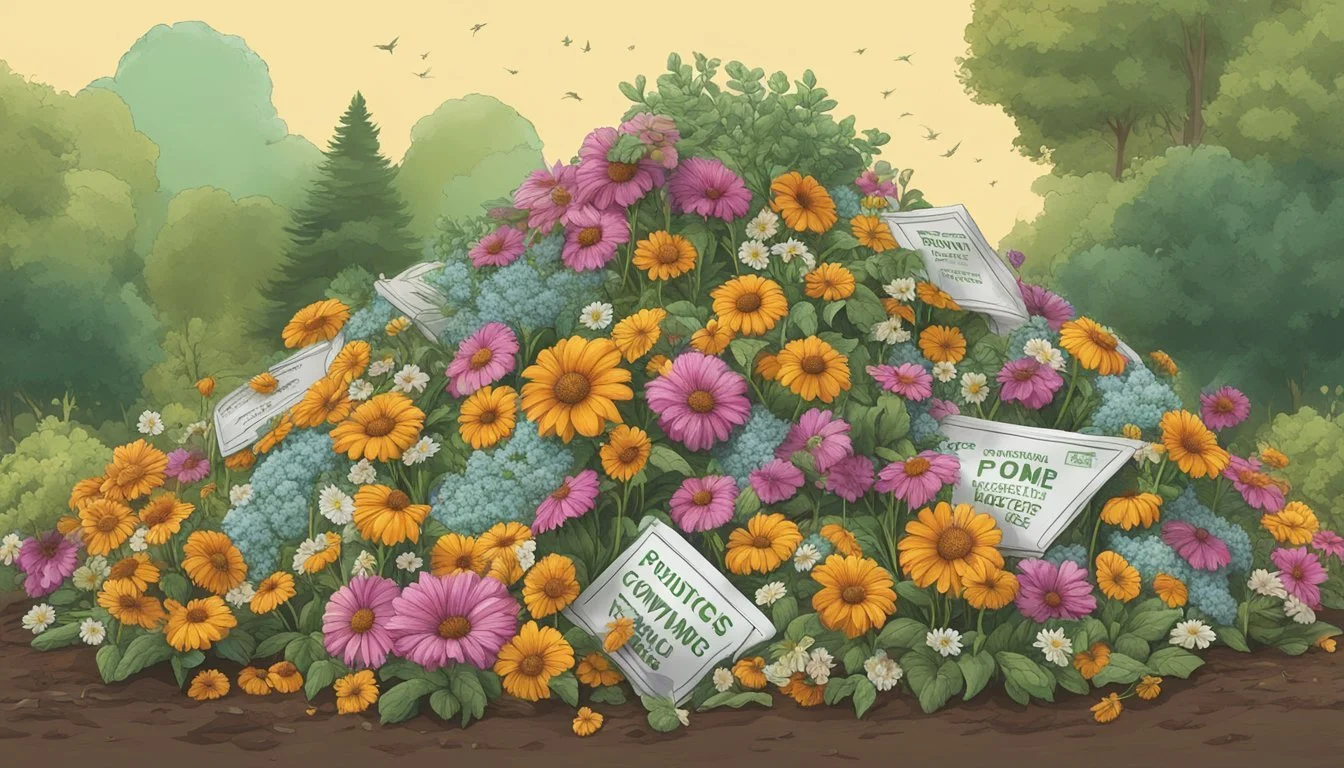Can You Compost Flowers with Pesticides?
Understanding the Risks and Best Practices
Composting is an eco-friendly process that converts organic materials, such as kitchen scraps and yard waste, into valuable fertilizer for the garden. In the context of flowers, it's generally encouraged to include them in compost as they can provide essential nutrients and improve the structural quality of the final compost product. However, when considering flowers that have been treated with pesticides, caution is necessary. The presence of chemical residues can raise concerns about the safety and purity of the resulting compost, particularly for those who wish to maintain an organic garden.
Pesticides used on flowers can be persistent, and their breakdown during the composting process isn't always guaranteed. This poses a risk of contaminating the compost with substances that may not only harm beneficial microorganisms within the pile but also potentially affect the health of plants and soil where the compost will be applied. Therefore, understanding the type of pesticides used on flowers and their compatibility with composting is crucial. Decompounding this issue, many gardeners might not be aware of the pesticide history of store-bought flowers, which further complicates the decision to compost them.
The decision to compost flowers with pesticides should consider several factors, including the concentration and type of pesticide applied, and how thoroughly it has been degraded before entering the compost pile. While organic materials are the backbone of healthy compost, introducing flowers with residual pesticides can undermine the benefits of composting. Therefore, for those aiming to maintain an organic composting system, sourcing flowers that are free from such chemicals or confirming their biodegradability becomes an essential practice.
Composting Basics
In composting, a precise balance of organic materials is required to create a beneficial environment where microorganisms can thrive and break down waste. This process transforms organic waste into valuable nutrients for soil health.
Understanding Compost Ingredients
The core ingredients of compost are divided into "green" and "brown" materials. Greens are rich in nitrogen and include items such as vegetable scraps, coffee grounds, and grass clippings. Browns provide carbon, essential for energy; examples include leaves, straw, and paper. An ideal compost pile requires a balance of these materials to maintain the right level of moisture and temperature for decomposition. A general ratio of 1 part green to 2-3 parts brown material is often recommended.
Green Materials (Nitrogen-Rich)
Fruit and vegetable scraps
Coffee grounds
Fresh grass clippings
Brown Materials (Carbon-Rich)
Dry leaves
Straw and hay
Shredded paper and cardboard
The Role of Microorganisms in Composting
Microorganisms are the powerhouse of the composting process. They include bacteria, fungi, and other organisms that consume organic waste. Their activity generates heat, which raises the temperature of the compost pile, speeds up decomposition, and helps to kill off pathogens. The compost pile should be kept aerated and moist to allow these microorganisms to work efficiently. If conditions are optimal—meaning there's a blend of greens and browns, sufficient moisture, and proper aeration—the composting process can turn kitchen scraps and yard waste into nutrient-rich compost that improves soil health and provides nutrients for plants.
Gardening with Compost
Incorporating compost, especially that derived from flowers, can significantly improve garden vitality by enriching soil health and aiding plant growth.
Enhancing Soil with Flower Compost
When gardeners compost flowers, they are adding a mix of green waste—the flower itself, providing nitrogen—and brown waste, such as stems and dried leaves, offering carbon. The decomposition process results in finished compost, a humus-like material teeming with beneficial microorganisms. This organic matter enhances the soil structure, increases its ability to retain water, and provides essential nutrients for plants.
Benefits for the Vegetable Garden:
Improves soil aeration, promoting root development
Supplies nutrients slowly, reducing the need for chemical fertilizers
Increases the population of beneficial soil organisms
How to Use in Gardens:
Spread a layer of finished compost on the garden bed.
Incorporate gently into the topsoil without disturbing root systems.
Allow plants to absorb nutrients throughout the growing season.
Using Compost as Mulch in Gardens
Compost can also serve as an effective mulch in gardens. Applying a layer of compost around plants can help retain soil moisture, suppress weed growth, and provide a slow release of nutrients. Over time, this layer will continue to break down, adding even more organic matter to the soil.
Mulching with Compost:
Apply 2-3 inches of compost around the base of plants, avoiding direct contact with stems.
Ensure that the compost is mature and free from any material that hasn't fully decomposed.
By using flower compost as both soil enhancer and mulch, gardeners can maintain a healthy, productive garden environment while promoting sustainable practices.
Potential Hazards of Pesticides in Compost
Incorporating flowers into compost piles comes with potential risks if pesticides are present. These substances may persist, influencing soil health and the composting process.
Identifying Pesticide Risks
Pesticides are known to include a wide array of chemicals capable of killing pests that harm plants. However, these substances can leave behind chemical residue that may end up in compost piles when treated plants are added. In compost, the breakdown of these pesticides varies significantly. While many degrade into harmless compounds, others resist degradation and can linger, raising concerns about the introduction of toxins into an otherwise eco-friendly system.
Fungicides, insecticides, and herbicides are typical pesticides that might be found on flowers.
Some, such as several herbicides, have been shown to persist due to their resistant chemical structures.
Organic options can also contain substances that act as pesticides and potentially impact the compost's quality.
Effects of Pesticides on Compost Quality
The presence of pesticides in compost can adversely affect its quality. Substances that do not fully decompose can lead to chemical residues in the compost, which may subsequently integrate into the soil health cycle. These residues sometimes function as disruptors, affecting non-target organic materials and beneficial microorganisms which are crucial for a healthy composting process.
Persistent pesticides potentially harm soil-dwelling organisms and contribute to diseases in plants.
Even trace amounts of certain herbicides detected can significantly impact sensitive garden plants.
The integration of pesticide-laden compost into gardens challenges the overall goal of creating an eco-friendly and organic growing environment.
Composting Flowers
When adding flowers to a compost pile, one needs to differentiate between those suitable for composting and those that may introduce harmful substances or diseases to the compost.
Sorting Flowers for Composting
Healthy Flowers:
Compostable: Undamaged, disease-free petals and stems from both garden and commercial sources.
Non-compacted Material: Ensure flowers have ample air space when added to compost to prevent anaerobic conditions.
Diseased or Treated Flowers:
Avoid Composting: Flowers showing signs of disease or treated with chemical pesticides should not be composted to prevent contamination.
Disposal: Dispose of these flowers through municipal green waste programs or according to local regulations.
Note: Flowers with non-organic residues like glitter, dye, or preservatives should also be excluded from compost.
Composting Different Types of Flowers
Composting Garden Flowers:
Deadheading: Remove spent blooms to encourage new growth and collect them for compost.
Variety: A mix of flower varieties adds a rich diversity of nutrients and microorganisms to the pile.
Composting Store-Bought or Commercial Flowers:
Pesticide Check: Confirm that flowers are free of synthetic chemicals before composting.
Prep Work: Remove any non-natural elements like strings or plastic wraps that do not break down.
Composting Approach:
Layering: Alternate layers of green material (fresh flowers) and brown material (dried flowers, leaves, etc.) to balance nitrogen and carbon.
Turning the Pile: Regularly turn the pile to aerate and accelerate decomposition.
By selectively composting and applying good composting practices, one can turn both garden and store-bought flowers into valuable compostable materials that benefit the environment and the soil.
Reducing Pesticide Impact
To ensure compost quality and environmental safety, reducing the pesticide impact on compost is crucial. Deploying green practices in pest management and adopting eco-friendly alternatives are effective strategies.
Strategies to Minimize Pesticide Use
Integrated Pest Management (IPM): IPM is an approach that emphasizes the use of multiple methods to control pests with minimal use of chemicals. Methods include crop rotation, using pest-resistant plant varieties, and biological controls such as beneficial insects.
Regular Monitoring: Constantly check plants for signs of pests. This enables early intervention with the least aggressive method, often reducing the need for chemical pesticides.
Precise Application: When pesticides are necessary, apply them directly to targeted areas to avoid widespread use. This reduces the amount of chemical entering the compost.
Alternatives to Chemical Pesticides
Organic Pesticides: Made from natural ingredients, organic pesticides often break down more quickly in compost than synthetic ones and are less likely to harm beneficial organisms.
Neem Oil: A plant-based product that serves as both a pesticide and a fungicide, neem oil is biodegradable and less harmful to the environment.
Insecticidal Soaps: These target specific pests and degrade rapidly, minimizing their impact on compost.
Cultural Practices: Adjusting planting times or using physical barriers can effectively reduce pests without any pesticide use, maintaining compost quality and lowering the carbon footprint associated with chemical manufacturing.
By integrating these measures, gardeners can protect their plants and pursue green practices, ultimately supporting eco-friendly composting efforts and decreasing environmental impact.
Composting Techniques
The effectiveness of composting, particularly with materials that may contain pesticides, hinges on the chosen technique and how well the compost pile is maintained.
Cold Composting vs. Hot Composting
Cold Composting: This method involves the simple piling of composting materials where they decompose over time. It requires less maintenance and is more forgiving with the composition of input materials; however, it might not reach the temperatures needed to break down pesticides efficiently.
Hot Composting: Contrary to cold composting, hot composting accelerates the decomposition by creating a balance of green compost material like vegetable scraps (high in nitrogen) and brown compost material such as dry leaves (high in carbon). A hot compost pile should be built in layers and requires regular turning to maintain aerobic conditions. This method can reach temperatures between 135-160 degrees Fahrenheit (57-71 degrees Celsius), which is more likely to break down pesticide residues.
Maintaining Proper Compost Conditions
Moisture levels: Optimal composting necessitates the compost to be as moist as a wrung-out sponge. If it's too dry, microbial activity slows down; if too wet, it can cause anaerobic conditions leading to odor and poor decomposition.
Turning: Regularly turning the compost pile introduces oxygen necessary for the aerobic breakdown of organic materials. The frequency of turning depends on the pile's temperature and texture—a sign that the material is well-aerated and active.
Through precise management of temperature, moisture, a balance of materials, and frequent aeration, composters can ensure that their pile degrades organic materials effectively, even in the presence of pesticide residues. This approach supports the composting process while addressing concerns about potential toxins.
Materials to Avoid in Compost
When composting, certain items can introduce risks to the health of the pile and, ultimately, the soil it will enrich. It is crucial to identify non-compostable materials including those treated with pesticides or having chemical residues, and to understand the proper disposal of such items.
Recognizing Non-Compostable Materials
Non-compostable materials can impede the composting process and may be harmful to the resulting compost. This category often includes:
Plastics: Unable to break down organically, creating pollution.
Metals and Glass: They do not decompose and can create physical hazards.
Chemically Treated Wood: May leach harmful chemicals into the compost.
Diseased Plants: Could spread pathogens throughout the compost pile.
Poisonous Plants: Their toxic properties may persist in the compost.
Dealing with Pesticide-Treated Flowers
Flowers treated with pesticides or other chemical agents can be problematic for compost for several reasons:
Residual Chemicals: Pesticides can remain on plant tissues and in the soil, potentially disrupting the delicate balance of the composting process.
Health Risks: Chemicals may pose a risk to beneficial organisms in the compost and eventually to the health of plants, animals, and humans that interact with the compost product.
For flowers that may contain chemical residue, it is advised to:
Avoid composting them in organic waste piles meant for garden use.
Consider alternative methods of disposal, such as municipal waste systems equipped to handle such materials.
Flowers, whether diseased or potentially poisonous, should also be kept out of the compost to prevent the spread of disease or toxins through the organic materials in the compost.
Composting and Environmental Sustainability
Composting stands as a cornerstone of sustainable practices, effectively reducing waste and replenishing ecosystems. It represents an eco-friendly avenue for transforming organic waste into valuable soil amendments, minimizing environmental impact and promoting a greener future.
Compost's Role in Waste Reduction
Composting significantly reduces the volume of waste destined for landfills by repurposing organic matter that would otherwise contribute to landfill mass. Compiling both green materials, such as kitchen scraps and plant trimmings, and brown materials, like dry leaves and cardboard, composting undercuts the traditional waste-disposal process. This act directly echoes in the form of a lower carbon footprint, given that organic waste in landfills generates methane, a potent greenhouse gas.
Benefits to landfills:
Decreases volume of waste.
Reduces methane emissions.
Mitigates potential leaching of hazardous substances.
Benefits of Composting for the Ecosystem
The compost produced from repurposed organic waste functions as an exceptionally nutrient-rich soil additive. It fosters the health and fertility of the soil, which benefits the ecosystem in several ways:
Improves soil structure, allowing for better water retention.
Encourages the proliferation of microorganisms beneficial to plant growth.
Reduces the need for chemical fertilizers, limiting the environmental impact of agricultural practices.
Can act as a pest-reducing agent, minimizing the reliance on harmful pesticides.
By integrating sustainable practices such as composting, communities and individuals contribute effectively to environmental preservation while bolstering the very foundations of global food security.









